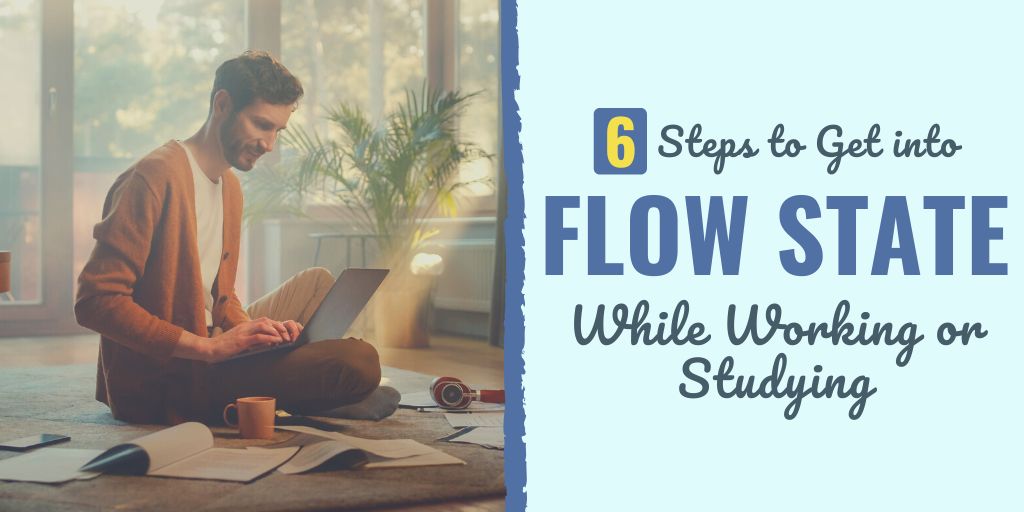There might be affiliate links on this page, which means we get a small commission of anything you buy. As an Amazon Associate we earn from qualifying purchases. Please do your own research before making any online purchase.
I’m sure you can think of a time when you were working on something that you had little to no interest in doing.
It’s tedious to watch the clock while you’re working, but you can’t help but do so if you’re disengaged or disinterested in the task. But this mental state certainly won’t allow you to be productive and also isn’t conducive to having a fulfilling day.
Now think of the exact opposite of that: being in a state of mind in which you’re so enraptured in what you’re doing that you’ve lost track of time. This describes being in a flow state–when you’re in the zone, acutely focused, and oblivious to anything unrelated that is going on around you.
This powerful concept has taken over the professional world and poured over into people’s personal lives, as people want to learn to boost their productivity, work efficiently, and feel accomplished.
In this article, we are going to take a look at what flow state is and why it is beneficial. Then we will review 6 steps you can take to get into this productive surge and cultivate flow on your own. Let’s start by learning more about the science behind flow state and how you can get carried away with your work.
What Is Flow State?
The theory of flow was introduced by psychologist Mihaly Csikszentmihalyi, whose works focused on happiness and productivity. In his book, Flow: The Psychology of Optimal Experience, Csikszentmihalyi describes this state as one in which people are so engrossed in what they’re doing that nothing else matters.
He goes on to theorize that experiencing flow state is so pleasurable that people seek it out at great cost, indicating that this is an intrinsically rewarding experience.
Csikszentmihalyi posits that people are mistaken by assuming they’re at their happiest while relaxing or taking a break from reality. The truth is that our best moments are not found in these passive moments, rather, they “occur if a person’s body or mind is stretched to its limits in a voluntary effort to accomplish something difficult and worthwhile.” -Csikszentmihalyi
He goes on to explain that people are at their happiest when they’re in a state of flow, which involves experiencing the following factors in an activity:
There isn’t one experience that can lead to flow; it could happen when you’re doing a variety of activities such as reading, creating art, writing, exercising, or gardening. Csikszentmihalyi noted that the actual experience in which one experiences flow matters less than the way the experience is approached.
What Are the Benefits of Flow State?
Flow state is where your best performance occurs. The work you’re able to accomplish at this time adds value and feels rewarding after you do it.
“Flow is important both because it makes the present instant more enjoyable, and because it builds the self-confidence that allows us to develop skills and make significant contributions to humankind” – Csikszentmihalyi

Being in a flow state is rewarding because of the mental engagement and focus that promote personal growth. But the neurological experience of flow is also beneficial– both when you’re in and once you’re out of flow state. Here are a few ways that flow benefits your overall wellbeing:
In gaining a sense of control, flow allows people to take an active role in their lives instead of simply reacting to external events. What this leads to is a more meaningful existence and an ability to make an impact on others by expanding your circle of control as you acquire possession of your life.
Now that you know the benefits of getting into flow state, let’s look at how you can put this into practice.
6 Steps to Get into Flow State While Working or Studying
1. Match Your Task to Your Skills
Flow occurs most often when your skill level aligns with the difficulty of the activity you’re doing. This means that when you practice and gain experience in any given task, you will be more likely to achieve flow.
Flow state can only occur when a task is challenging enough to keep your attention without it being too difficult. If something is too challenging, it can become stressful and therefore frustrating. On the other hand, if something is too easy, you’re likely to become bored, which isn’t conducive to reaching a flow state.
If possible, try to adjust any simple task you’re doing so it’s enjoyable, meaningful, and challenging. On the other hand, break down complicated tasks into smaller, simplified steps.
Once your skills match the difficulty of the task at hand, you will achieve a challenge-skill balance.
2. Establish Clear Goals
Having a clear goal is an essential element of getting into a flow state while working or studying. If you lack clarity about your goal, your brain won’t be able to settle into its optimum concentration and you’ll either jump from task to task or fall victim to common distractions, which will both prevent you from achieving flow state.
However, when you know exactly what you need to accomplish, you can measure your progress and recognize if you’re successfully completing the task.
Therefore, choose just one specific task to work on at a time. Whether that’s writing a paper, reading a book, or working on a graphic design project, be clear about what you’re working on. Your brain can only focus on one thing at a time–and when you try to multitask, you’re simply forcing your brain to go back and forth between multiple things at once, which is a cognitive burden.
3. Focus on the Process
While you definitely want to have a goal, achieving flow also requires enjoying the process rather than zeroing in on the end result. Allow yourself to be mindful of the present without only thinking about the outcome of your efforts.
It may seem counterintuitive, but when you stop focusing so much on your end-goal and pay more attention to the process of getting there, positive results will just happen. By enjoying the journey easing into your destination, you won’t experience burnout or exhaustion.

If you don’t appreciate your journey–or you don’t see your work as a journey at all because you’re too caught up with reaching your goal, you likely don’t feel fulfilled by what you’re doing. In a way, enjoying the journey is the defining factor of getting into a flow state, because without this, you won’t be able to engage in your work.
4. Eliminate Distractions
Research has found that in order to achieve flow state, you need to get rid of any potential distractions, because when your focus is affected, your flow state will be broken. While flow state is a strong experience, it is also somewhat fragile. It can be easy to be pulled out of it by everyday interruptions.
The average worker gets distracted every 11 minutes–and it takes 25 minutes to get back on track. This can undermine your best intentions when you’re working or studying, so you need to be proactive in limiting these distractions.
Silence your phone, close your door, disable all alerts, close your social media and email tabs, get rid of unneeded objects that are in your working area, and get into a quiet environment.
While you probably can’t isolate yourself all day, you need to make your environment as conducive to flow as possible.
In addition to eliminating external distractions, you also need to consider potential internal distractions. If you’re stressed or overwhelmed, it will be difficult to maintain focus, making it impossible to reach flow state.
If you frequently feel like you have too much going on to focus, two things you can try are daily journaling and meditation. Both of these activities will help get rid of intrusive thoughts and give you more control over your ability to focus.
5. Do Something You Like
If you dread doing a certain task, you’re not going to be able to lose yourself in it. Flow state is derived from intrinsic motivation, meaning you’re engaging in something that you want to do. People seek out flow state because it feels good to be productive when you’re doing something that you enjoy, as it is personally satisfying.
What captivates people to getting into flow state is the pleasure that comes with doing something that you’re passionate about. From there, the type of enjoyment that you can gain from this state of being goes well beyond the temporary exhilaration to create an overall sense of well-being and long term feelings of happiness and fulfillment.
6. Practice
Achieving flow takes practice. Every step from finding the right task to maintaining your focus, to clearing distractions will take time. But every time you fail, you will learn from your mistakes. And every time you succeed, you can reflect on what worked well for you so you can focus on that more in the future.
It’s important to understand that the key to getting into flow is the ability to create the right circumstances that work for you. So consider some factors that have helped you in the past when you’re trying to enter this state.
As with anything else, the more practice you get, the better you’ll be. Studies have found that one way to practice reaching flow state is to simply practice mindfulness because there is a significant association between flow state and mindfulness ability. Achieving flow state is hugely rewarding, so it’s important to practice it to improve your ability to reach it.
Final Thoughts on Steps to Get Into Flow State
As one of the more productive states to achieve, I encourage you to take the steps laid out in this article to get into flow state as often as you can. But remember, achieving flow state is a delicate process that can’t be accomplished by just learning about it.
Finding ways to increase the amount of time we are in flow state increases engagement, satisfaction, and creativity. Whether you’re studying, working, or playing, you’ll feel better when you’re in flow.
To supplement your ability to reach flow state, check out these productivity hacks that you can use at work or while studying.

Connie Mathers is a professional editor and freelance writer. She holds a Bachelor's Degree in Marketing and a Master’s Degree in Social Work. When she is not writing, Connie is either spending time with her daughter and two dogs, running, or working at her full-time job as a social worker in Richmond, VA.


